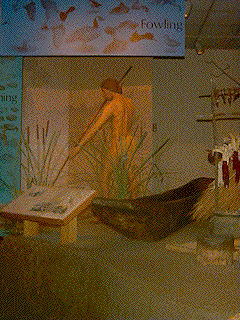
| Environment | Technology | Settlement | Economy | Society | Health | Religion | Art |
| How-Do-We-Know? | |||||||
| Paleo-Indian | Archaic | Woodland | Mississippian | European Contact |

The importance of domesticated crops for Mississippian peoples is seen in the abundant presence of charred corn kernels and cobs, beans, and squash rinds and seeds in garbage pits; the number of chert hoes and hoe fragments; and the chemical composition of the bones of Mississippian people.
Equally important to these first American Bottom farmers were the diverse and plentiful aquatic resources of the numerous sloughs, swamps and backwater lakes that dominated the Mississippi valley landscape.
The importance of the close proximity of productive fields, aquatic habitats and wetlands to Mississippian farmsteads, hamlets, villages, and mound centers cannot be overstated. The proximity of easily harvested resources allowed, for the first time in human history, the significant involvement of all members of a family in the household economy. Storage of food increased people's reliability and reduced risk. Mississippian people also hunted and gathered other seasonally available foods such as ducks, fish, mussels, nuts, acorns and other seeds. Because these resources were near people's homes, more children and older adults could be easily and productively involved in the subsistence economy.
The Mississippian economy involved more than just subsistence. Exchange in both local as well as exotic, non-local materials played a significant role. High quality chert was mined at quarries located in the Shawnee Hills in present day southern Illinois and used throughout the American Bottom in the manufacture of hoes and other stone tools. Exotic materials such as Gulf Coast marine shell, upper midwest copper, and Appalachian mica, bauxite from present-day Arkansas were imported for ornamental symbols to advertise the religious and political importance of some high status groups or individuals such as chiefs and priests.
| Paleo-Indian | Archaic | Woodland | Mississippian | European Contact |